Introduction
In an era where data reigns supreme, predictive AI emerges as a transformative force, empowering organizations to anticipate future trends and make informed decisions with unprecedented accuracy. By harnessing historical data and advanced algorithms, companies can not only streamline operations but also enhance customer experiences across various sectors, from healthcare to finance.
As industries increasingly adopt this technology, the integration of predictive analytics with tools like Robotic Process Automation (RPA) unveils a pathway to operational excellence, reducing inefficiencies and maximizing resource allocation.
However, the journey is not without its challenges, as organizations must navigate data quality issues and resistance to change. This article delves into the multifaceted world of predictive AI, exploring its mechanisms, real-world applications, and the critical balance between leveraging its benefits while addressing inherent challenges.
As businesses stand on the brink of a new technological frontier, understanding and embracing predictive AI will be essential for driving innovation and achieving sustained growth.
Defining Predictive AI: Concepts and Mechanisms
The predictive AI definition illustrates a crucial segment of artificial intelligence that leverages historical information and advanced statistical algorithms to forecast future outcomes. By carefully examining patterns and trends within large information sets, forecasting AI systems produce informed predictions about events, behaviors, and market trends. Essential to this technology are mechanisms such as machine learning, information mining, and statistical modeling, which enable forecasting AI to learn from previous information and improve its precision over time.
Companies increasingly recognize AI’s potential to accelerate growth within the IT sector, which highlights the predictive AI definition and its role across diverse industries such as finance and healthcare. In healthcare, for example, companies encountered challenges such as manual information entry errors and slow software testing that hindered efficiency. The implementation of GUI automation addressed these issues, reducing entry errors by 70% and improving workflow efficiency by 80%.
Furthermore, the rise of Small Language Models and GenAI Workshops are transforming business operations by improving data quality and providing tailored training solutions for organizations. In the context of decentralized work environments, predictions indicate that by 2025, 50% of knowledge workers will utilize virtual assistants, with many asserting that these technologies significantly enhance productivity and quality of life. However, public sentiment around AI adoption underscores the need for safety and security measures, as 85% of the general public believes a nationwide effort is necessary.
Additionally, the EMMA RPA solutions provide a pathway to modernizing outdated systems, further enhancing operational efficiency. As we progress, understanding the predictive AI definition and embracing anticipatory AI, along with innovative solutions like EMMA RPA, will be crucial for operational leaders striving to streamline processes and stay competitive in a swiftly evolving technological landscape.
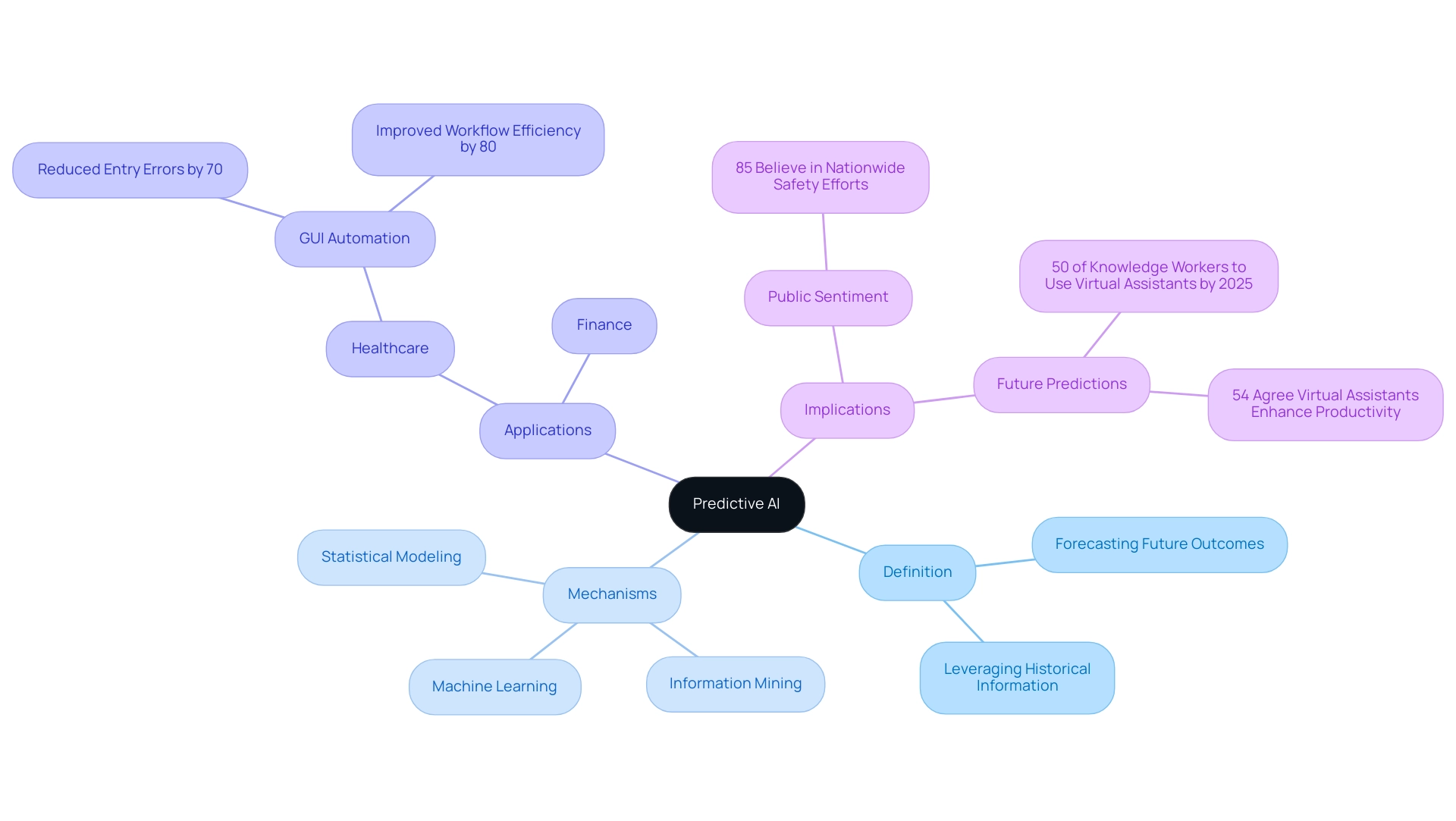
Real-World Applications of Predictive AI: Transforming Industries
The predictive AI definition illustrates how it is fundamentally transforming industries by providing organizations with the tools to effectively anticipate future trends and behaviors. In the healthcare sector, predictive analytics is essential for forecasting patient admissions, enabling hospitals to optimize resource allocation and enhance overall patient care. As one industry leader noted, these advancements are pivotal for ‘improving overall patient care.’
This is especially crucial as 80 percent of US healthcare providers significantly boost their IT and software investments, with AI advancements leading the charge. Additionally, 56% of healthcare leaders plan to invest in generative AI solutions within the next three years, indicating a strong future direction for AI in healthcare. Combined with Robotic Process Automation (RPA), which streamlines manual workflows and reduces mistakes, these technologies are essential in overcoming implementation challenges such as manual information entry errors and slow software testing.
RPA not only enhances operational efficiency, achieving a 70% reduction in entry mistakes and an 80% improvement in workflow effectiveness, but also allows teams to focus on more strategic, value-adding initiatives. Furthermore, the significance of Business Intelligence cannot be overstated; it converts raw information into actionable insights, driving informed decision-making for business growth. As companies harness predictive models across various sectors, from retail to finance, they enhance operational efficiency, which aligns with the predictive AI definition and paves the way for smarter, more responsive business practices.
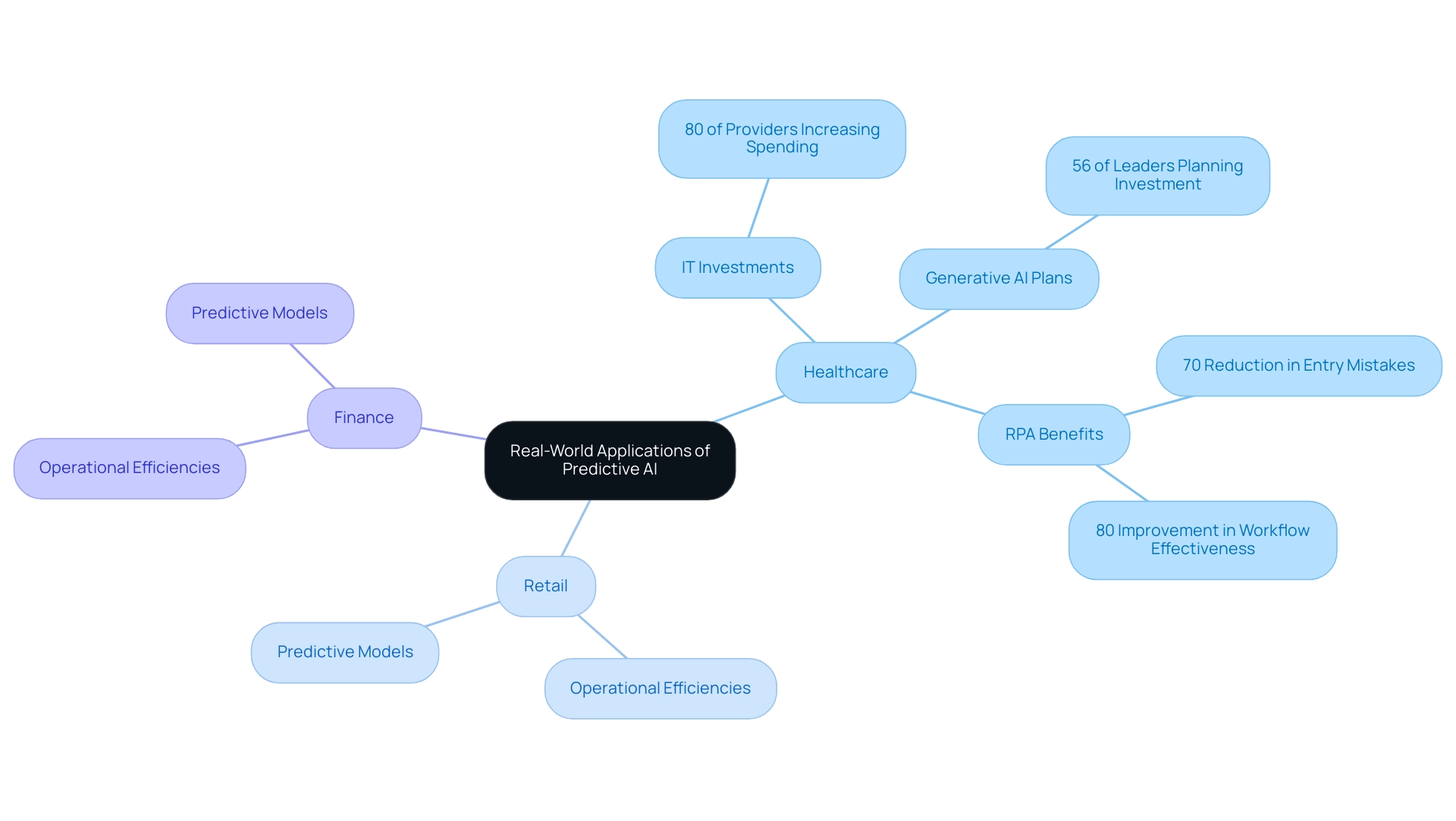
Predictive AI vs. Generative AI: Key Differences and Synergies
Predictive AI and generative AI represent two distinct yet complementary facets of artificial intelligence. The predictive AI definition highlights how this technology primarily focuses on predicting future events through the analysis of historical data, allowing entities to make informed decisions based on expected outcomes. In contrast, generative AI focuses on creating new content—be it images, text, or music—by learning intricate patterns from existing datasets.
As Nicholas Renotte, Chief AI Engineer at IBM Client Engineering, aptly points out,
For example, lots of businesses want to generate a financial forecast, but that’s not typically going to require a gen AI solution, especially when there are models that can do that for a fraction of the cost.
This distinction is crucial for organizations aiming to leverage AI effectively. The importance of these innovations is highlighted by the projected influence of generative AI, which encompasses a 3x rise in MBE value and the establishment of roughly 13,000 new jobs, enhancing the net worth of the Black community by about $2 billion.
Furthermore, the case analysis named ‘Direct Investment into SCI’ demonstrates a practical use, highlighting how investments in community projects can create direct influence, possibly improved by forecasting and generative AI methods. Nonetheless, the two innovations can collaborate efficiently; for example, generative AI can create artificial information that boosts the training of predictive models, thus enhancing their precision and reliability. This interplay is increasingly relevant, particularly as organizations modernize with solutions like EMMA RPA for automation and tailored Small Language Models for enhanced data analysis and privacy.
The GenAI workshops provide hands-on training that equips teams with the skills to implement these technologies effectively, while tailored AI solutions address specific business challenges, driving productivity and innovation. Such integrations not only streamline operations but also empower businesses to make informed, strategic decisions in a rapidly evolving AI landscape.
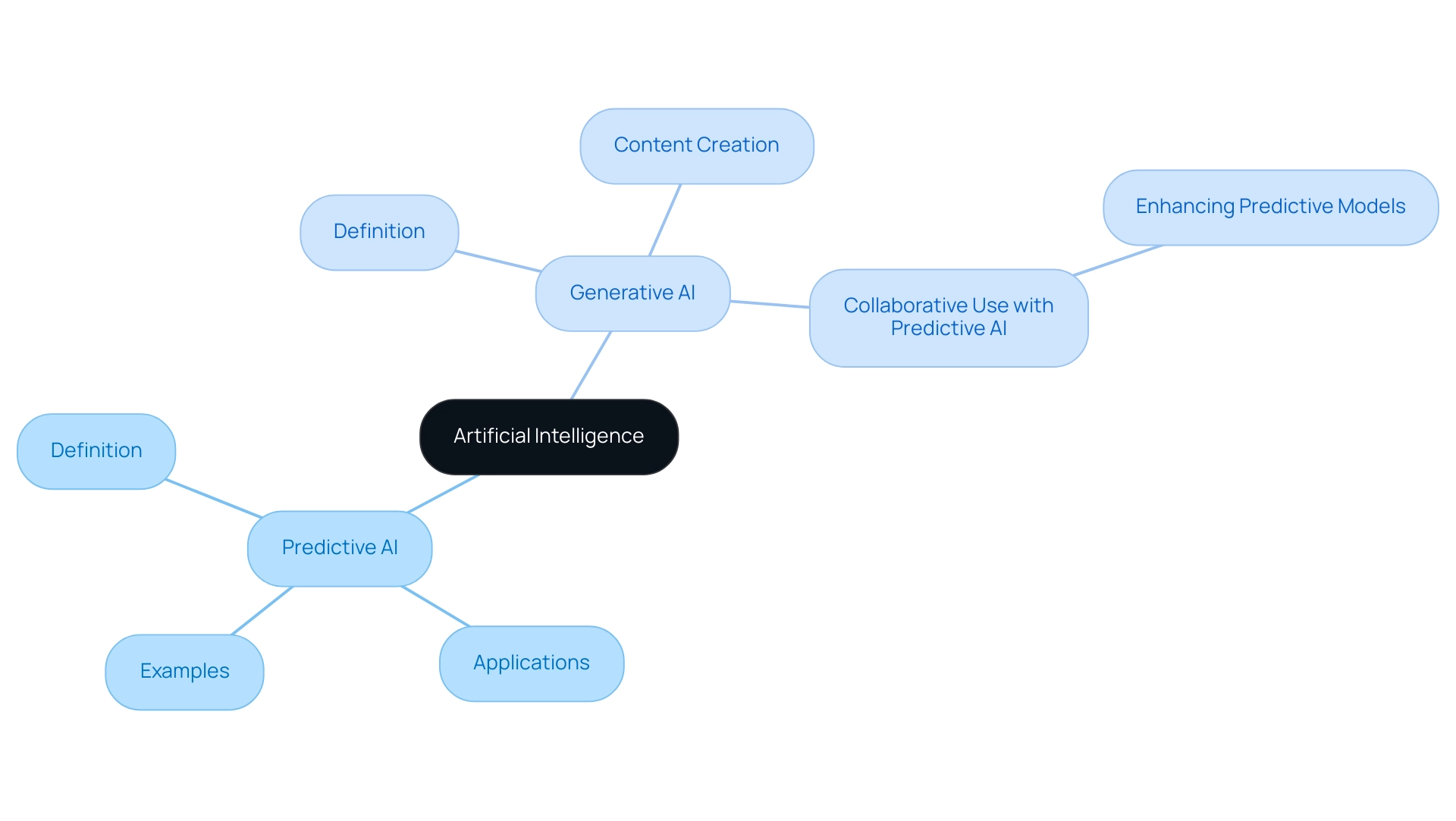
Benefits and Challenges of Implementing Predictive AI
Implementing forecasting AI presents a wealth of benefits that can transform organizational operations, such as significantly improved operational efficiency, enhanced decision-making capabilities, and the proactive anticipation of customer needs. By utilizing analytical forecasting alongside Robotic Process Automation (RPA), companies can optimize resource allocation, thereby reducing costs and minimizing waste—an essential advantage in today’s competitive landscape. RPA can also address staffing shortages by automating repetitive tasks, allowing employees to focus on higher-value work, and modernize outdated systems to improve overall productivity.
Notably, AI-powered self-driving vehicles are projected to generate over $170 billion in annual revenue worldwide, highlighting the lucrative potential of AI integration. However, entities often encounter challenges that can impede successful implementation. Key hurdles include:
- Ensuring data quality
- Integrating existing systems with the predictive AI definition
- Overcoming resistance to change among staff
The recent Executive Order issued by the White House in October 2023 underscores the importance of establishing new AI safety and security standards, further complicating the regulatory landscape entities must navigate. Additionally, while the rapid growth of voice assistant technology—evidenced by over 4 billion devices in use worldwide, projected to reach 8.4 billion by 2024—illustrates successful AI integration, it also highlights the challenges of job displacement and privacy concerns associated with AI adoption. As of 2023, machine learning technologies have only a 2.6% representation in job advertisements, signaling a need for greater awareness and training in this area.
By proactively addressing these challenges and overcoming the drawbacks of AI through customized RPA solutions and utilizing Business Intelligence to convert data into actionable insights, companies can unlock the full potential of forecasting AI, driving efficiency and growth into 2024 and beyond. Furthermore, enhancing workplace productivity and morale through automation can alleviate the burden of repetitive tasks, address talent retention issues, and modernize outdated systems, creating a more dynamic and innovative operational environment.
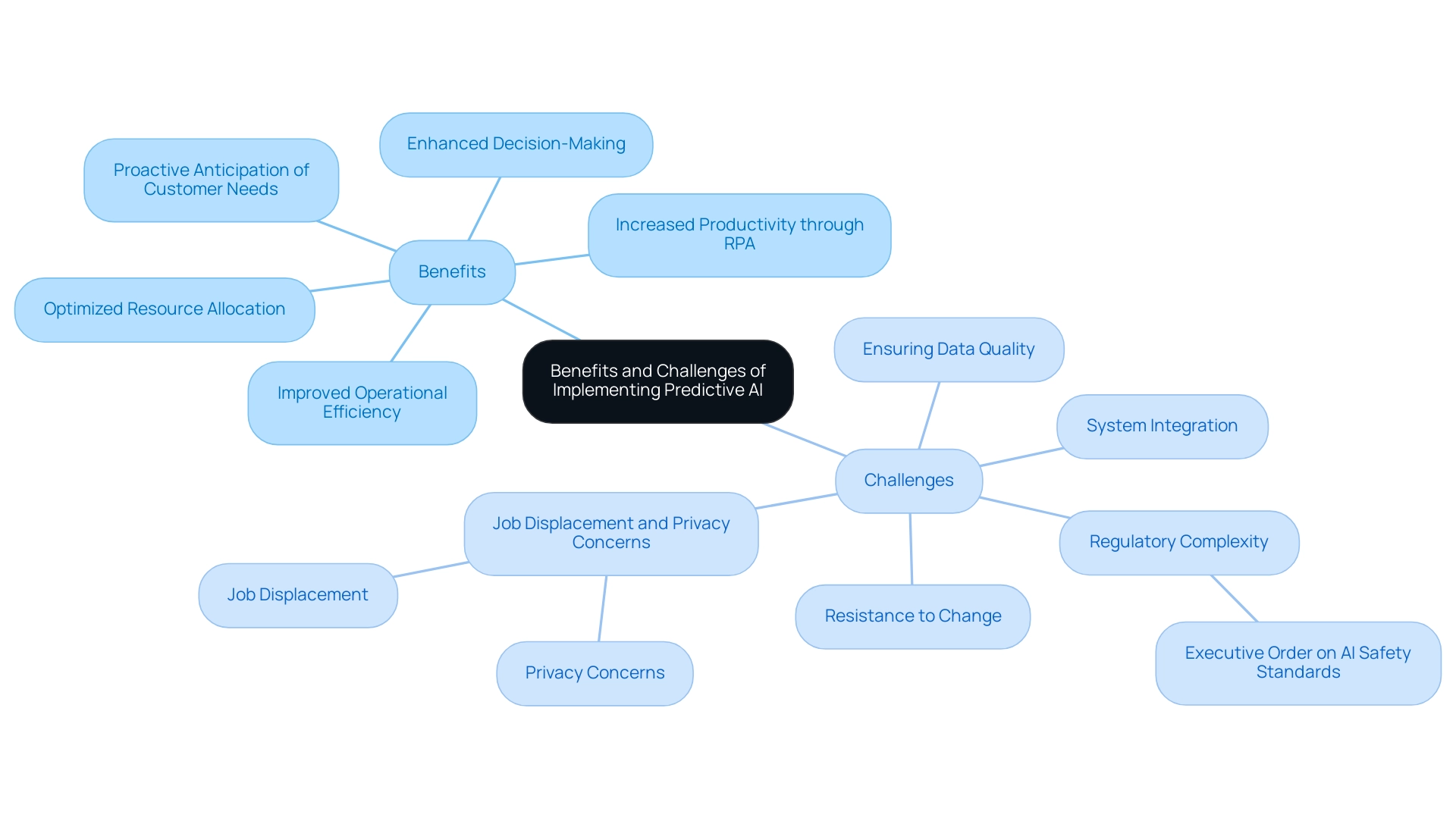
The Future of Predictive AI: Trends and Innovations
The predictive AI definition points to a future that is exceedingly promising, driven by rapid advancements in machine learning algorithms and the growing computational capabilities that facilitate more sophisticated analyses. Significantly, 31% of entities have reported accelerated decision-making processes due to Big Data and AI solutions, underscoring the tangible benefits of these technologies. However, many organizations face challenges in AI adoption, often perceiving these projects as complex, costly, and difficult to integrate into existing workflows.
This perception is compounded by concerns over poor master data quality, which can hinder effective AI implementation. This is where tools like Robotic Process Automation (RPA) come into play, streamlining manual processes to enhance operational efficiency. The merging of AI with the Internet of Things (IoT) is especially significant, as it improves the precision and real-time relevance of forecasting models across various sectors.
As AKM Aminul Islam noted, ‘Generative artificial intelligence (AI) models, or Gen-AI for short, started as a way to create chatbots,’ highlighting the evolution of AI technologies that feed into predictive analytics. Innovations like explainable AI are set to revolutionize the landscape by introducing greater transparency in decision-making processes. This not only builds trust in the predictions generated by these systems but also enables entities to make informed choices.
Furthermore, utilizing Business Intelligence tools is essential for converting raw information into actionable insights, fostering growth and innovation. However, organizations must address challenges related to data quality, accessibility, and security, as emphasized in the case study titled ‘Data Management as an AI Bottleneck.’ As businesses increasingly embrace digital transformation, the predictive AI definition, which is supported by RPA and robust Business Intelligence strategies, will undoubtedly become a cornerstone for driving innovation and achieving a competitive edge, enabling leaders to navigate complex operational challenges with confidence.
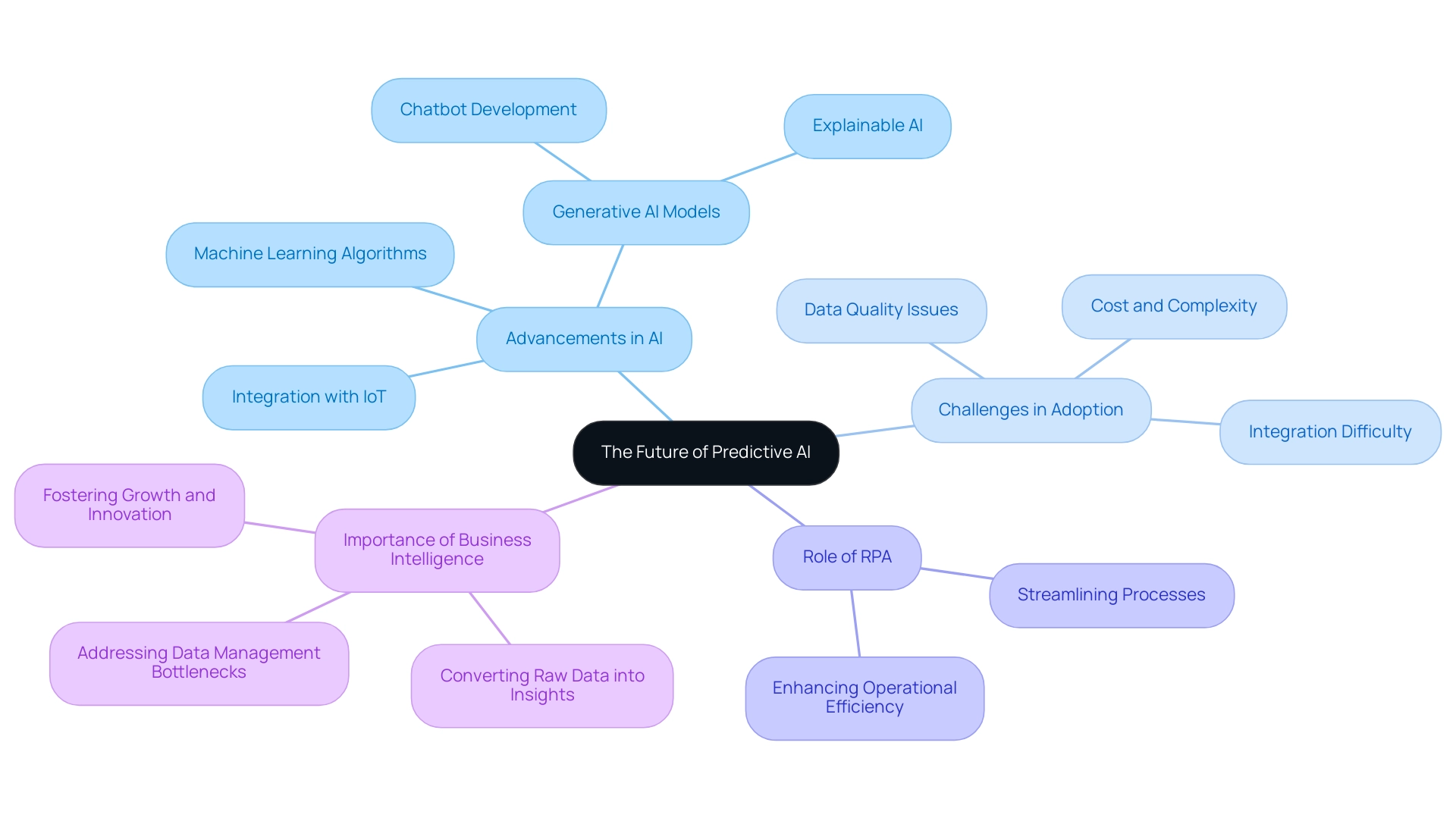
Conclusion
Predictive AI stands at the forefront of technological advancement, offering organizations the ability to forecast future trends and optimize operations across various sectors. By harnessing historical data and sophisticated algorithms, businesses can enhance decision-making, improve customer experiences, and drive significant efficiencies. The integration of predictive analytics with tools like Robotic Process Automation (RPA) not only simplifies workflows but also addresses common challenges such as data entry errors and slow processes, allowing teams to focus on strategic initiatives.
Despite the promising benefits, organizations must navigate hurdles like data quality issues and resistance to change. These challenges, coupled with the evolving regulatory landscape surrounding AI, necessitate a proactive approach to implementation. By investing in tailored solutions and fostering a culture of innovation, companies can unlock the full potential of predictive AI, transforming operational efficiency and ensuring sustained growth.
As industries continue to evolve, embracing predictive AI is not merely an option but a necessity for organizations aiming to thrive in an increasingly competitive environment. The future is bright for those willing to leverage these technologies, as they pave the way for smarter, more responsive business practices that will define success in the years to come. By committing to this journey, organizations can not only enhance their operations but also position themselves as leaders in their respective fields, ready to meet the challenges and opportunities that lie ahead.

